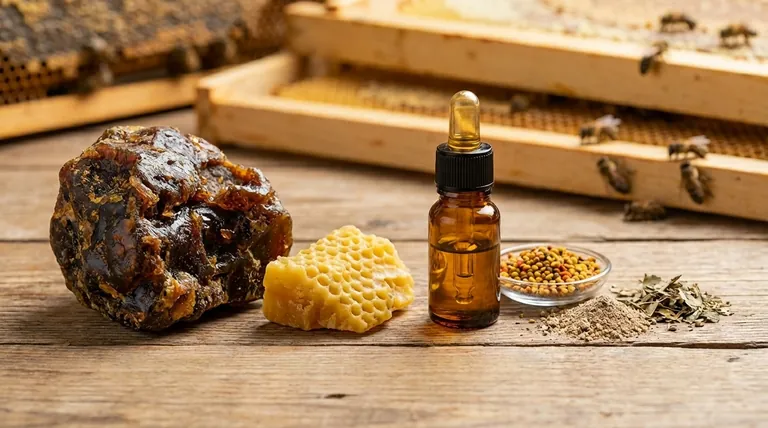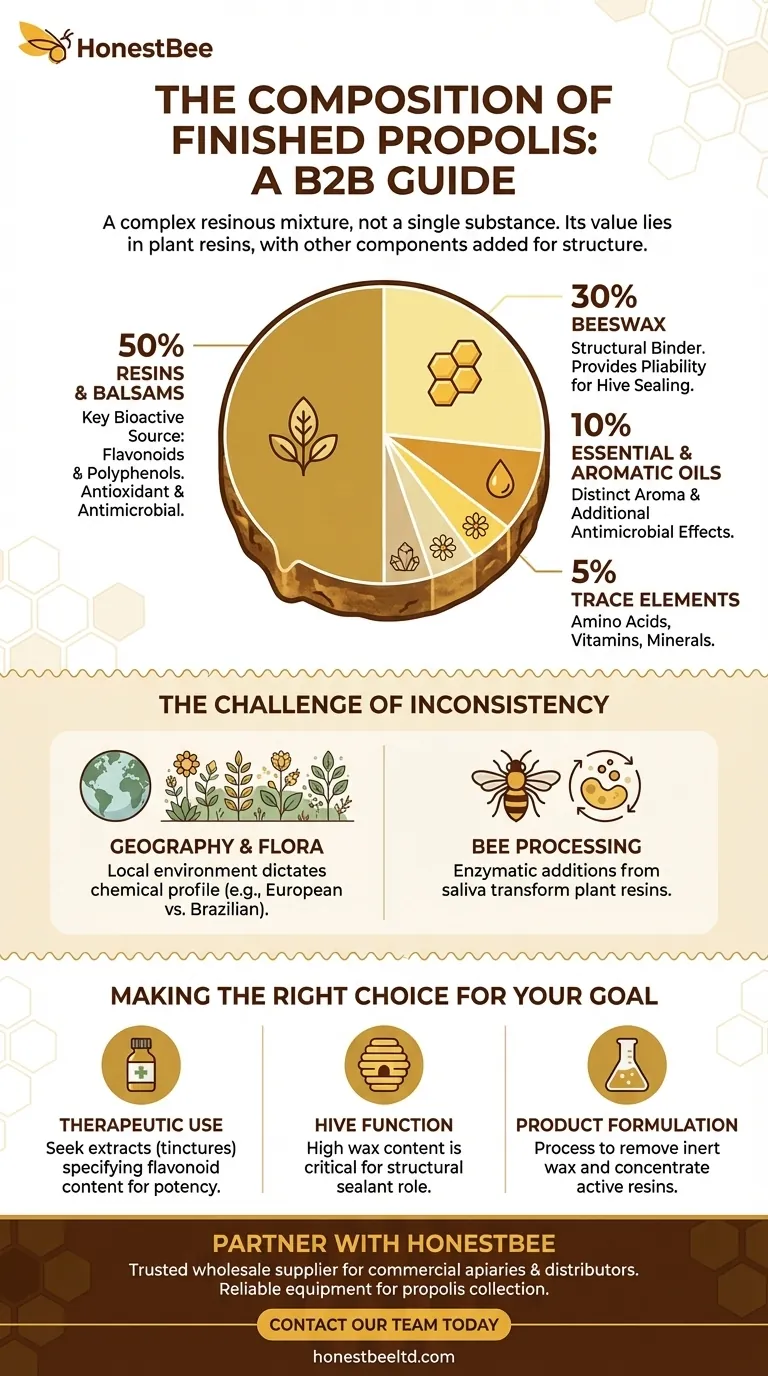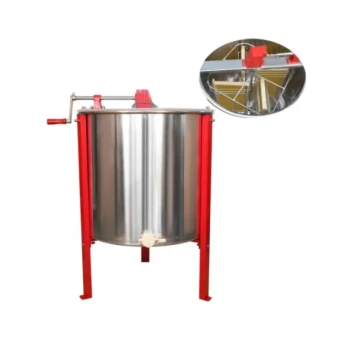On average, finished propolis is a complex resinous mixture composed of approximately 50% resins and balsams, 30% beeswax, 10% essential and aromatic oils, and 5% pollen. The remaining 5% consists of a variety of organic compounds and trace minerals, including amino acids and vitamins, which are introduced through the plant sources and the bees' own salivary secretions.
Propolis is not a single substance but a highly variable natural composite. Its core function and value come from the plant resins bees collect, while the other components are either added by the bees for structural integrity or are incidental to the collection process.

The Core Building Blocks of Propolis
Propolis begins as a raw material collected by bees from tree buds, sap flows, or other botanical sources. The bees then metabolize and mix this material to create the finished product used to seal and protect the hive.
Resins and Balsams (≈50%)
This is the largest and most biologically active component of propolis. These plant-derived resins are rich in polyphenols and flavonoids, which are the primary sources of the antioxidant and antimicrobial properties attributed to propolis.
The specific chemical makeup of these resins is entirely dependent on the local flora available to the bees.
Beeswax (≈30%)
Bees add their own wax to the collected plant resin. This wax acts as a plasticizer and structural binder, making the sticky resin more pliable and suitable for use as a construction and sealing material within the hive.
Essential and Aromatic Oils (≈10%)
These volatile compounds are carried over from the original plant sources. They contribute to the distinct aroma of propolis and also possess their own antimicrobial properties, adding to its overall protective effect.
Pollen (≈5%)
Pollen is largely considered an incidental component. It gets mixed into the propolis as bees collect and transport the sticky resins back to the colony.
Trace Elements (≈5%)
This final portion is a complex mixture of micronutrients. It includes amino acids, vitamins (like B-vitamins), and minerals such as magnesium, zinc, and iron, all derived from the original plant material.
The Challenge of Inconsistency
The single most important factor to understand about propolis is its variability. The percentages provided are merely a general average.
The Influence of Geography
The chemical profile of propolis is a direct reflection of its environment. Propolis from a European poplar forest will have a vastly different composition and active compound profile than propolis from a Brazilian jungle.
This is why you often see propolis marketed by its geographical origin—the location dictates its fundamental properties.
The Role of Bee Processing
The bees themselves alter the substance by adding their own salivary secretions. These secretions contain enzymes that begin to break down and transform the plant resins, contributing to the final unique composition.
Making the Right Choice for Your Goal
Understanding this composition helps you select the right type of propolis for your needs.
- If your primary focus is therapeutic use: Look for extracts (like tinctures) that specify the flavonoid or polyphenol content, as this is a better measure of potency than the raw percentages of its components.
- If your primary focus is understanding its hive function: Recognize that the high wax content is critical for its role as a structural sealant and has less to do with its biological activity.
- If your primary focus is product formulation: Be aware that raw propolis must often be processed to remove the inert beeswax to concentrate the active resins for use in supplements or cosmetics.
Ultimately, appreciating propolis means appreciating its role as a dynamic, functional material created by the unique interaction between a honeybee colony and its local environment.
Summary Table:
| Component | Average Percentage | Key Function |
|---|---|---|
| Resins & Balsams | ≈ 50% | Source of antimicrobial & antioxidant properties (flavonoids, polyphenols) |
| Beeswax | ≈ 30% | Provides structural integrity and pliability for hive sealing |
| Essential & Aromatic Oils | ≈ 10% | Contributes to aroma and adds antimicrobial effects |
| Pollen | ≈ 5% | Incidental component from collection process |
| Trace Elements | ≈ 5% | Includes amino acids, vitamins, and minerals from plant sources |
Ready to Source High-Quality Propolis or Beekeeping Equipment?
As a trusted wholesale supplier to commercial apiaries and distributors, HONESTBEE provides the reliable equipment and supplies you need for successful propolis collection and overall hive management. Our expertise ensures you get products that support the health of your bees and the quality of your yield.
Contact our team today to discuss your wholesale needs and discover how we can support your operation's growth.
Visual Guide

Related Products
- Plastic Queen Marking Tube Cage with Plunger for Beekeeping
- 10L Stainless Steel Electric Honey Press Machine
- Electric 8 Frame Honey Spinner Extractor Equipment for Beekeeping
- Queen Bee Marking Pen UNI Medium Point for Queen and Bee Marking
- HONESTBEE 4 Frame Manual Self Reversing Honey Extractor for Beekeeping
People Also Ask
- How is a queen bee marked using a handheld queen marking cage? A Step-by-Step Guide for Beekeepers
- How does a press-in cage work for marking a queen bee? A Safer, Simpler Method for Beekeepers
- What should be done after marking a Queen bee? Ensure a Safe Return and Hive Harmony
- Why are Posca pens commonly used for marking queen bees? The Safest, Most Durable Method for Beekeepers
- What is a tube queen cage, and how is it used? A Guide to Safe Queen Marking













